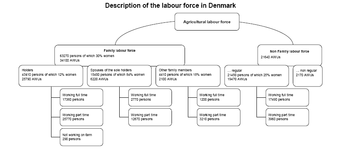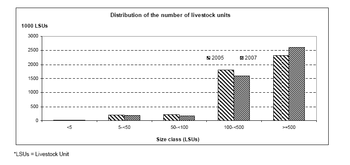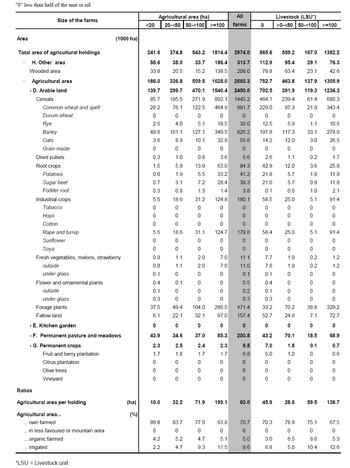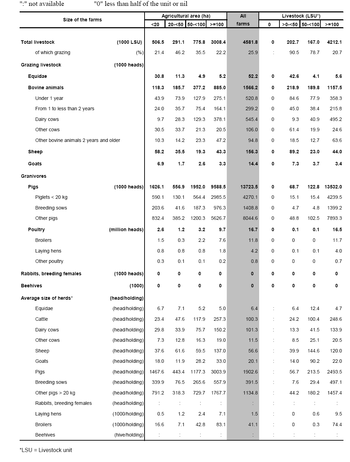- Data from May 2008. Most recent data: Further Eurostat information, Main tables and Database.
This article is part of a series of country-specific essays on the results of the European Union (EU) Farm structure survey (FSS) 2007. It provides a brief but nevertheless comprehensive insight into farm structure in Denmark.
The 2007 FSS recorded 44 618 agricultural holdings in Denmark, which represents a 14 % decrease since 2005. This drop is due to the decrease in the number of all farms under 100 ha.
Main statistical findings
The agricultural area per holding increases by 14 % since 2005
In 2007, about 44 360 agricultural holdings in Denmark had an economic size of at least one European size unit (ESU), compared to 51 300 in 2005.
These farms made use of 2.66 million hectares (ha) of utilised agricultural area (UAA), which makes the average size of a holding in Denmark 60 ha (a 14 % increase from the 2005 value of 52.7 ha/holding). See Figure 1 for the distribution of UAA in terms of farm size, while Table 2 describes the size distribution and other characteristics of the agricultural holdings.
These holdings employed 55 700 annual work units (AWU), the equivalent of 55 700 people working full time. The organisation and distribution of the labour force in Denmark is described in Figure 2 and Table 1.
The farms contained 4.58 million livestock units (LSU) in 2007. The distribution of livestock by farm size is shown in Table 4 and Figure 3.
Amongst the 44 360 agricultural holdings in 2007:
- 53 % made use of less than one AWU, while another 20 % made use of two or more AWUs;
- 4 % used less than 5 ha, while 34 % used 50 ha or more;
- 38 % specialised in cereals, oil seed and protein crops;
- 17 % were engaged in general field cropping;
- 10 % of the holdings specialised in dairy farming
Amongst the sole holders:
- 12 % were women in 2007;
- 45 % were aged 55 or more and 6 % were younger than 35 years; and
- 48 % of sole/main holders had another gainful activity in 2007.
In Denmark in 2007, 71 % of the agricultural area was owned by the farmers.
The labour force has decreased by 8 % from 2005 to 2007. Considering the regular labour force, the reduction was 12.5 % during the same period.
The area farmed under organic production methods represents 133 115 ha (5 % of the utilized agricultural area), compared to 5.2 % in 2005). Details of land use by size of farm are given in Table 3.
The share of farms with another gainful activity than agricultural production rose from 18 % in 2005 to 23 % in 2007.
In Denmark 61 % of the agricultural land and 66% of the livestock are in farms with 100 ha or more of agriculture area.
The situation for subsistence farming in Denmark is outlined in Table 5.
Data sources and availability
Due to the different coverage of the FSS across Member States, the total number of farms is not comparable between countries. This is why the present analysis, including Tables 1-4 and the graphs focus on holdings of at least one European size unit.
The survey on the structure of agricultural holdings in Denmark was carried out in June 2007 on a sample basis. Prior to this survey, a full-scale agricultural census was last conducted in 1999.The reference day of the farm structure survey was the 15 June 2007 in the case of land area, land use and livestock. For the labour force characteristics the reference period was the 12 months preceding the reference day of the survey.
According to the national definition, an agricultural holding is an economic and technical unit which produces agricultural products and which can be run by one person, by a group of persons or by a company. Units having the agriculture as the secondary activity are also included.
On the basis of the Statistical Farm Register (that has been updated by the subsequent sample surveys from 2001-2006), a stratified sample was drawn. The holdings – including the newly-established ones – have been stratified into 8 groups by economic size of the farms (using standard gross margin (SGM) at 1995 prices), by regions (9 regions) and by type of farming (11 categories significant in Denmark). In practice 700 strata were used (from the 792 possible). In each stratum farms are selected randomly. The extrapolation factor is calculated simply as the number of farms in the population divided by the number of farms in the sample within each stratum. Some specific horticultural farms were covered exhaustively (type of farming 21, 32 and 61). The selection ratio is also 100 % for all the new and for big farms (with over 100 ha of agriculture area). In 2007 the sample consisted of 24 865 units which, when extrapolated, provided 44 618 farms.
The list of characteristics and their definitions were fully compliant with the EU requirements concerning the Farm structure survey 2007. However, when calculating the stratum by the type of farming, one group is calculated differently from the common European standard. In Denmark the farm type 61 includes all farms where more than 1/2 of the standard gross margin (SGM) comes from the sum of horticulture and permanent crops (except those farms which are classified under 21 and 32), instead of considering type 61 all the farms with at least 1/3 of the SGM from horticulture and another 1/3 from permanent crops.
In Denmark the FSS makes use of data from other registers in order to reduce the burden on the farmers and also to diminish the expenses of the survey. 44 characteristics of the FSS are drawn from the Integrated Administration and Control System (IACS) register, the registrations of bovine animals and the Organic Farm Register.
The data are controlled at different levels. They are checked manually for major differences among farms included in previously surveys. The first check covers 15 to 20 % of the questionnaires, and the doubts are removed by telephone contacts with the farmers. In a second step unrealistic and missing data are checked automatically. A final control is done on the aggregated results, compared with the previous ones by checking the discrepancies.
Non-response is not a significant problem in the Danish FSS concerning only 0.5 %of the farms. For strata's with non-response the extrapolation factor is corrected proportionately to the non-response. The information from previous surveys and experts’ opinions were also used.
Between FSS 2005 and 2007 "maintaining land in good agricultural and environmental conditions (GAEC)" became an agricultural activity and the concerned land has been included in the agricultural area. In Denmark it covers 2 100 ha, all the area being in farms with at least 1 ESU.
Annual work unit (AWU) is equivalent to a worker employed on a full time basis for one year. In Denmark it is 1800 hours (225 working days of 8 working hours per day).
Context
European Commission rural development policy aims to improve competitiveness in agriculture and forestry, improve the environment and countryside, improve the quality of life in rural areas and encourage the diversification of rural economies.
As agriculture has modernised and the importance of industry and services within the economy has increased, so agriculture has become much less important as a source of jobs. Consequently, increasing emphasis is placed on the role farmers can play in rural development, including forestry, biodiversity, the diversification of the rural economy to create alternative jobs and environmental protection in rural areas.
The FSS continues to adapt to provide timely and relevant data to help analyse and follow these developments.
See also
Further Eurostat information
Publications
- Farm Structure Survey in Denmark - 2007 - Statistics in focus 80/2008
- National Methodological Report – FSS 2007 Denmark (available on request)
Main tables
- Agriculture, see:
- Farm structure: historical data (1990-2007) (t_ef)
Database
- Agriculture, see:
- Farm structure (ef)
Dedicated section
- Ad-hoc tables: Farm Structure Survey
Methodology / Metadata
- Farm structure (ESMS metadata file — ef_esms)
External links
- Statistics Denmark - Focus on agriculture and fishery
- Statistics Denmark - StatBank, see Subjects - Agriculture and fishery








